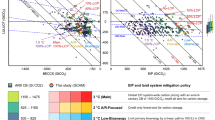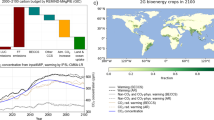Abstract
Integrated assessment models generate climate change mitigation scenarios consistent with global temperature targets. To limit warming to 2 °C, cost-effective mitigation pathways rely on extensive deployments of CO2 removal (CDR) technologies, including multi-gigatonne yearly CDR from the atmosphere through bioenergy with carbon capture and storage (BECCS) and afforestation/reforestation. While these assumed CDR deployments keep ambitious temperature targets in reach, the associated rates of land-use transformation have not been evaluated. Here, we view implied integrated-assessment-model land-use conversion rates within a historical context. In scenarios with a likely chance of limiting warming to 2 °C in 2100, the rate of energy cropland expansion supporting BECCS proceeds at a median rate of 8.8 Mha yr−1 and 8.4% yr−1. This rate exceeds—by more than threefold—the observed expansion of soybean, the most rapidly expanding commodity crop. In some cases, mitigation scenarios include abrupt reversal of deforestation, paired with massive afforestation/reforestation. Historical land-use transformation rates do not represent an upper bound for future transformation rates. However, their stark contrast with modelled BECCS deployment rates implies challenges to explore in harnessing—or presuming the ready availability of—large-scale biomass-based CDR in the decades ahead. Reducing BECCS deployment to remain within these historical expansion rates would mean either the 2 °C target is missed or additional mitigation would need to occur elsewhere.
This is a preview of subscription content, access via your institution
Access options
Access Nature and 54 other Nature Portfolio journals
Get Nature+, our best-value online-access subscription
$29.99 / 30 days
cancel any time
Subscribe to this journal
Receive 12 digital issues and online access to articles
$119.00 per year
only $9.92 per issue
Buy this article
- Purchase on Springer Link
- Instant access to full article PDF
Prices may be subject to local taxes which are calculated during checkout




Similar content being viewed by others
References
Clarke, L. et al. in Climate Change 2014: Mitigation of Climate Change Ch. 6 (Cambridge Univ. Press, 2015).
Azar, C., Johansson, D. J. A. & Mattsson, N. Meeting global temperature targets—the role of bioenergy with carbon capture and storage. Environ. Res. Lett. 8, 1–8 (2013).
Calvin, K. et al. 2.6: Limiting climate change to 450 ppm CO2 equivalent in the 21st century. Energy Econ. 31, S107–S120 (2009).
Friedlingstein, P. et al. Persistent growth of CO2 emissions and implications for reaching climate targets. Nat. Geosci. 7, 709–715 (2014).
Smith, P. et al. Biophysical and economic limits to negative CO2 emissions. Nat. Clim. Change 6, 42–50 (2016).
Rose, S. K. et al. Bioenergy in energy transformation and climate management. Clim. Change 123, 477–493 (2014).
Fuss, S. et al. Betting on negative emissions. Nat. Clim. Change 4, 850–853 (2014).
Anderson, K. & Peters, G. The trouble with negative emissions. Science 354, 182–183 (2016).
Tavoni, M. & Socolow, R. Modeling meets science and technology: an introduction to a special issue on negative emissions. Clim. Change 118, 1–14 (2013).
Van Vuuren, D. P. et al. The role of negative CO2 emissions for reaching 2 ºC—insights from integrated assessment modelling. Clim. Change 118, 15–27 (2013).
Popp, A. et al. Land-use transition for bioenergy and climate stabilization: model comparison of drivers, impacts and interactions with other land use based mitigation options. Clim. Change 123, 495–509 (2014).
Popp, A. et al. Land-use futures in the shared socio-economic pathways. Glob. Environ. Change 42, 331–345 (2017).
Bruinsma, J. World Agriculture: Towards 2015/2030. An FAO Perspective (Earthscan, 2002).
Smith, L. J. & Torn, M. S. Ecological limits to terrestrial biological carbon dioxide removal. Clim. Change 118, 89–103 (2013).
Peters, G. P. et al. Key indicators to track current progress and future ambition of the Paris Agreement. Nat. Clim. Change 7, 118–122 (2017).
Robiou du Pont, Y. et al. Equitable mitigation to achieve the Paris Agreement goals. Nat. Clim. Change 7, 38–43 (2016).
FAOSTAT: Crops (FAO, 2016); http://www.fao.org/faostat/en/#data/QC/.
Alexandratos, N. & Bruinsma, J. World Agriculture Towards 2030/2050: the 2012 Revision ESA Working Paper No. 12-03 (FAO, 2012).
Byerlee, D., Falcon, W. P. & Naylor, R. L. The Tropical Oil Crop Revolution (Oxford Univ. Press, New York, NY, 2017).
Wise, M. et al. Implications of limiting CO2 concentrations for land use and energy. Science 324, 1183–1186 (2009).
FAOSTAT: Land Use (FAO, 2016); http://www.fao.org/faostat/en/#data/RL.
Lima, M., Skutsch, M. & Costa, G. D. M. Deforestation and the social impacts of soy for biodiesel: perspectives of farmers in the South Brazilian Amazon. Ecol. Soc. 16, 4 (2011).
Fitzherbert, E. B. et al. How will oil palm expansion affect biodiversity? Trends Ecol. Evol. 23, 538–545 (2008).
Fuss, S. et al. Research priorities for negative emissions. Environ. Res. Lett. 11, 11 (2016).
Klein, D. et al. The value of bioenergy in low stabilization scenarios: an assessment using REMIND-MAgPIE. Clim. Change 123, 705–718 (2014).
Sanchez, D. L., Nelson, J. H., Johnston, J., Mileva, A. & Kammen, D. M. Biomass enables the transition to a carbon-negative power system across western North America. Nat. Clim. Change 5, 230–234 (2015).
Lomax, G., Lenton, T. M., Adeosun, A. & Workman, M. Investing in negative emissions. Nat. Clim. Change 5, 498–500 (2015).
Gibbs, H. K. et al. Tropical forests were the primary sources of new agricultural land in the 1980s and 1990s. Proc. Natl Acad. Sci. USA 107, 1–6 (2010).
Koh, L. P. & Wilcove, D. S. Is oil palm agriculture really destroying tropical biodiversity? Conserv. Lett. 1, 60–64 (2008).
Morton, D. C. et al. Cropland expansion changes deforestation dynamics in the southern Brazilian Amazon. Proc. Natl Acad. Sci. USA 103, 14637–14641 (2006).
Calvin, K. et al. Trade-offs of different land and bioenergy policies on the path to achieving climate targets. Clim. Change 123, 691–704 (2014).
Koh, L. P. & Ghazoul, J. Biofuels, biodiversity, and people: understanding the conflicts and finding opportunities. Biol. Conserv. 141, 2450–2460 (2008).
Chum, H. et al. The IPCC Special Report on Renewable Energy Sources and Climate Change Mitigation Ch. 2 (Cambridge Univ. Press, 2011).
Grassini, P., Eskridge, K. M. & Cassman, K. G. Distinguishing between yield advances and yield plateaus in historical crop production trends. Nat. Commun. 4, 1–11 (2013).
Caldas, M. M. et al. Factors affecting farmers’ willingness to grow alternative biofuel feedstocks across Kansas. Biomass Bioenergy 66, 223–231 (2014).
Song, F., Zhao, J. & Swinton, S. M. Switching to perennial energy crops under uncertainty and costly reversibility. Am. J. Agric. Econ. 93, 764–779 (2011).
Edmonds, J. et al. Can radiative forcing be limited to 2.6 Wm–2 without negative emissions from bioenergy and CO2 capture and storage? Clim. Change 118, 29–43 (2013).
Lotze-campen, H. et al. Impacts of increased bioenergy demand on global food markets: an AgMIP economic model intercomparison. Agric. Econ. 45, 103–116 (2014).
Barr, K. J., Babcock, B. A., Carriquiry, M. A., Nassar, A. M. & Harfuch, L. Agricultural land elasticities in the United States and Brazil. Appl. Econ. Perspect. Policy 33, 449–462 (2011).
Swinton, S. M., Babcock, B. A., James, L. K. & Bandaru, V. Higher US crop prices trigger little area expansion so marginal land for biofuel crops is limited. Energy Policy 39, 5254–5258 (2011).
Lark, T. J., Salmon, J. M. & Gibbs, H. K. Cropland expansion outpaces agricultural and biofuel policies in the United States. Environ. Res. Lett. 10, 044003 (2015).
Lynd, L. R. et al. How biotech can transform biofuels. Nat. Biotechnol. 26, 169–172 (2008).
Sims, R. E. H., Mabee, W., Saddler, J. N. & Taylor, M. An overview of second generation biofuel technologies. Bioresour. Technol. 101, 1570–1580 (2010).
United States Environmental Protection Agency 81 FR 89746— Renewable Fuel Standard Program: Standards for 2017 and Biomass-Based Diesel Volume for 2018 (Office of the Federal Register, National Archives and Records Administration, 2016).
Williams, C. L., Westover, T. L., Emerson, R. M., Tumuluru, J. S. & Li, C. Sources of biomass feedstock variability and the potential impact on biofuels production. Bioenergy Res. 9, 1–14 (2016).
Tillman, D. A. Biomass cofiring: the technology, the experience, the combustion consequences. Biomass Bioenergy 19, 365–384 (2000).
Gollakota, S. & McDonald, S. Commercial-scale CCS project in Decatur, Illinois—construction status and operational plans for demonstration. Energy Procedia 63, 5986–5993 (2014).
Koelbl, B. S., van den Broek, M. A., Faaij, A. P. C. & van Vuuren, D. P. Uncertainty in carbon capture and storage (CCS) deployment projections: a cross-model comparison exercise. Clim. Change 123, 461–476 (2014).
Mac Dowell, N., Fennell, P. S., Shah, N. & Maitland, G. C. The role of CO2 capture and utilization in mitigating climate change. Nat. Clim. Change 7, 243–249 (2017).
Popp, A. et al. The economic potential of bioenergy for climate change mitigation with special attention given to implications for the land system. Environ. Res. Lett. 6, 034017 (2011).
Krey, V., Luderer, G., Clarke, L. & Kriegler, E. Getting from here to there—energy technology transformation pathways in the EMF27 scenarios. Clim. Res. 123, 369–382 (2014).
Kriegler, E. et al. The role of technology for achieving climate policy objectives: overview of the EMF 27 study on global technology and climate policy strategies. Clim. Change 123, 353–367 (2014).
Blanford, G. J., Kriegler, E. & Tavoni, M. Harmonization vs. fragmentation: overview of climate policy scenarios in EMF27. Clim. Change 123, 383–396 (2014).
Acknowledgements
This work was funded by the David and Lucile Packard Foundation and Alexander von Humboldt Foundation. We thank S. Benson, E. Baik and S. Li for helpful discussions. We also thank the FAO and IAM community for making data publically accessible.
Author information
Authors and Affiliations
Contributions
P.A.T., C.B.F., D.B.L. and K.J.M. designed the research. P.A.T. analysed the data and drafted the paper. P.A.T., C.B.F., D.B.L., D.L.S. and K.J.M. revised the paper.
Corresponding author
Ethics declarations
Competing interests
The authors declare no competing interests.
Additional information
Publisher’s note: Springer Nature remains neutral with regard to jurisdictional claims in published maps and institutional affiliations.
Rights and permissions
About this article
Cite this article
Turner, P.A., Field, C.B., Lobell, D.B. et al. Unprecedented rates of land-use transformation in modelled climate change mitigation pathways. Nat Sustain 1, 240–245 (2018). https://doi.org/10.1038/s41893-018-0063-7
Received:
Accepted:
Published:
Issue Date:
DOI: https://doi.org/10.1038/s41893-018-0063-7
This article is cited by
-
Sustainable irrigation and climate feedbacks
Nature Food (2023)
-
Mapping the shared socio-economic pathways onto the Nature Futures Framework at the global scale
Sustainability Science (2023)
-
High energy and fertilizer prices are more damaging than food export curtailment from Ukraine and Russia for food prices, health and the environment
Nature Food (2022)
-
Framing the future of the Koronivia Joint Work on Agriculture from science-based evidence. A review
Agronomy for Sustainable Development (2022)
-
Constraints and enablers for increasing carbon storage in the terrestrial biosphere
Nature Reviews Earth & Environment (2021)



